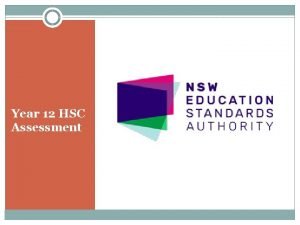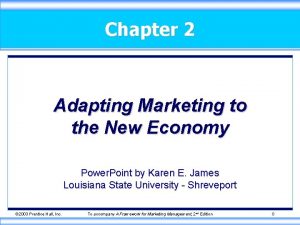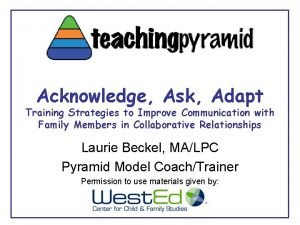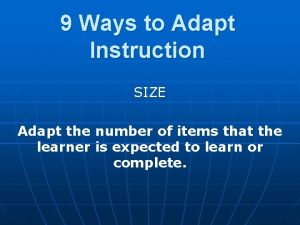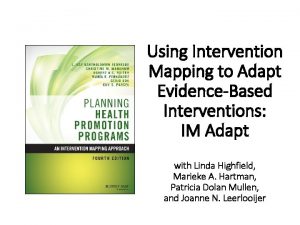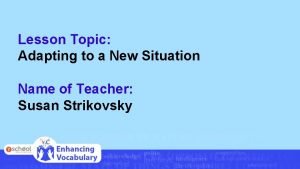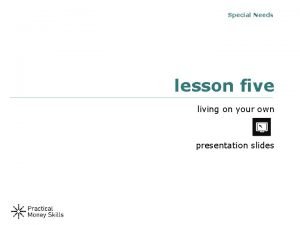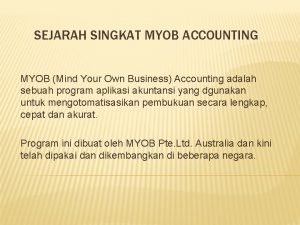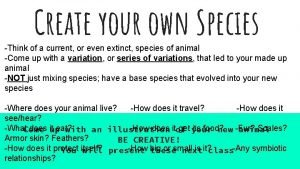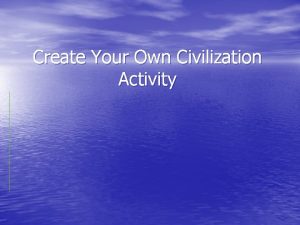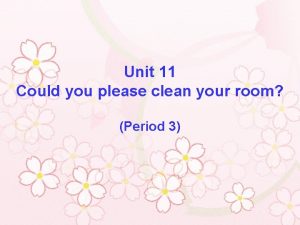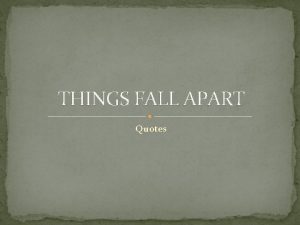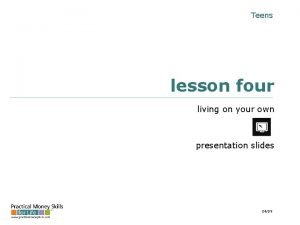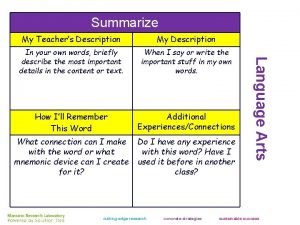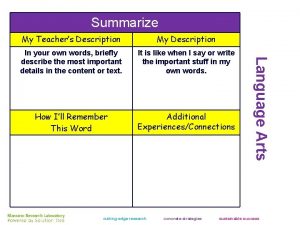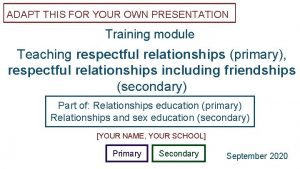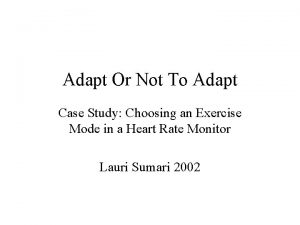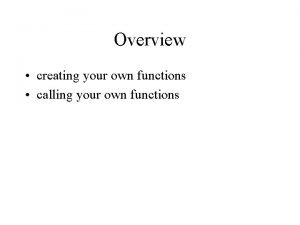ADAPT THIS FOR YOUR OWN PRESENTATION Training module







![Friendships support at [school name] Our leads [Names, contact details of friendships support] Our Friendships support at [school name] Our leads [Names, contact details of friendships support] Our](https://slidetodoc.com/presentation_image_h/1adc35a051564685fb9ff2bfd0f36998/image-8.jpg)
![Teaching about caring friendships at [school name] Ways in which we already teach about Teaching about caring friendships at [school name] Ways in which we already teach about](https://slidetodoc.com/presentation_image_h/1adc35a051564685fb9ff2bfd0f36998/image-9.jpg)











































- Slides: 52

ADAPT THIS FOR YOUR OWN PRESENTATION Training module Teaching about caring friendships Part of: Relationships education (primary) [YOUR NAME, YOUR SCHOOL] Primary September 2020

Contents 3 About this training module 5 Teaching the new curriculum 11 Safeguarding 14 Ground rules 17 Primary curriculum 34 Examples of good practice 37 Activities and templates for trainers 2

About this training module Subject leads can use the adaptable slides and ‘activities and templates for trainers’ section at the end of this module to help shape training sessions for teachers. This non-statutory training module supplements the statutory guidance on teaching about caring friendships, which schools should read in full. Schools can choose whether and how to follow or adapt this training module and should refer to the Early Career Framework for pedagogical guidance. 3

What you get out of today By the end of this training you should: ● ● know what is included in the statutory guidance know some key knowledge and facts to cover as part of this topic have strategies to deal with questions that come up in class feel more confident teaching about caring friendships 4

Teaching the new curriculum 5

Related topics Caring friendships is closely related to the following topics: ● respectful relationships ● intimate relationships and sexual health (secondary only) Therefore, you should: ● consider thematic links across key topics and the whole school when planning and delivering lessons ● find ways to link knowledge and vocabulary across topics 6

Related guidance Schools may also want to refer to the guidance for schools on preventing and responding to bullying (including cyberbullying) when planning to teach this subject. 7
![Friendships support at school name Our leads Names contact details of friendships support Our Friendships support at [school name] Our leads [Names, contact details of friendships support] Our](https://slidetodoc.com/presentation_image_h/1adc35a051564685fb9ff2bfd0f36998/image-8.jpg)
Friendships support at [school name] Our leads [Names, contact details of friendships support] Our policies [Add details - e. g. school policy on bullying] Specialist support [Add details - e. g. providers school already works with] Other information [Add resources] 8
![Teaching about caring friendships at school name Ways in which we already teach about Teaching about caring friendships at [school name] Ways in which we already teach about](https://slidetodoc.com/presentation_image_h/1adc35a051564685fb9ff2bfd0f36998/image-9.jpg)
Teaching about caring friendships at [school name] Ways in which we already teach about caring friendships at our school: ● [add details] 9

Pupils with SEND You will need to plan lessons to allow all pupils to access and practise the core knowledge, using your expertise as you normally would. You might want to link lesson outcomes with statutory ‘preparing for adulthood’ outcomes for those with an education, health and care (EHC) plan. (See SEND code of practice, section 8. ) STATUTORY GUIDANCE In special schools and for some SEND pupils in mainstream schools there may be a need to tailor content and teaching to meet the specific needs of pupils at different developmental stages. As with all teaching for these subjects, schools should ensure that their teaching is sensitive, age-appropriate, developmentally appropriate and delivered with reference to the law. (p 15) 10

Safeguarding 11

Safeguarding (1) Pupils may be affected by issues discussed in lessons. Let your designated safeguarding lead or deputy and any other relevant staff, such as pastoral leads, know what you are teaching. This will enable them to identify and speak to relevant pupils, especially those who they know may have been directly impacted by issues covered in the lessons and those with adverse childhood experiences. Teachers may need to deal with disclosures or concerns (e. g. of abuse or offending behaviour) in a way that safeguards pupils in line with school policies, especially the child protection policy. 12

Trusted adults Within this module we have used the term trusted adult. A trusted adult will generally be someone who children feel comfortable to turn to for help. Obvious examples include family members, teachers and doctors. It will be important when teaching this topic, and any other relevant topics, that teachers explore this concept. Pupils should be comfortable and capable of identifying who their trusted adults could be both within their families and wider circles. 13

Ground rules 14

Create class ground rules Clear class ground rules can help when teaching about sensitive topics. They also support confidentiality and safeguarding of pupils. Good practice is for ground rules to be: ● ● ● discussed and understood by all clear and practical modelled by the teacher followed consistently and enforced updated when needed visible in lessons (for example, posters) 15

Example ground rules Respect privacy. We can discuss examples but do not use names or descriptions that identify anyone, including ourselves. Listen to others. It is okay to disagree with each other, but we should listen properly before making assumptions or deciding how to respond. When disagreeing, challenge the statement not the person. No judgement. We can explore beliefs and misunderstandings about a topic without fear of being judged. Choose level of participation. Everyone has the right to choose not to answer a question or join discussion. We never put anyone ‘on the spot’ (no personal questions or pressure to answer). 16

Primary curriculum 17

Happy and secure friendships (1) Explain that friendship is a relationship between two or more people who care about each other and choose to have a relationship together. STATUTORY GUIDANCE Know how important friendships are in making us feel happy and secure, and how people choose and make friends. Teach pupils that friendship of all ages is usually based on something which binds people together, for example: ● ● ● liking to play with each other enjoying each other’s company having similar interests and hobbies enjoying the same activities having shared experiences, e. g. becoming friends after a trip Primary 18

Happy and secure friendships (2) Teach pupils that friendships make us feel happy and secure by giving us: ● ● ● people to enjoy time with and share experiences company so that we are not alone a feeling of belonging support when we need it someone to look out for us someone to share our problems with Explain that friendship is something that is freely given. People who ask us to do things in return for their friendship may not be real friends. STATUTORY GUIDANCE Know how important friendships are in making us feel happy and secure, and how people choose and make friends. Primary 19

Ways of making friends Explain the ways that people make friends includes: ● ● ● saying hello to someone and talking to them showing an interest in what someone is doing and asking them about it inviting them to join a group asking them if they want to play or if you can play with them doing something nice for them or saying something nice to them Explain that sometimes it is not always easy to make friends, and that they can ask a trusted adult for support. STATUTORY GUIDANCE Know how important friendships are in making us feel happy and secure, and how people choose and make friends. Primary 20

Choosing friends (1) STATUTORY GUIDANCE Know how important Teach that friends do not have to look the same or come friendships are in making us feel happy and secure, from the same background. We can be friends with and how people choose anyone, e. g. boys and girls can be friends. and make friends. Friendships with people who are different to us can be rewarding, makes life more interesting and exposes us to different experiences and knowledge. Explain we can make friends anywhere, for example: ● ● at school at after school clubs through our family or existing friends with neighbours or in the wider community Primary 21

Choosing friends (2) Explain that the number of friends we have does not matter. We can be friends with one person or many people. STATUTORY GUIDANCE Know how important friendships are in making us feel happy and secure, and how people choose and make friends. Explain that some friends may be particularly important to us at different times. Sometimes we might consider several people to be equally important as friends, or that we have a 'best friend'. There are no rules and friendships can change over time. Primary 22

Online friendships Explain that the internet can give us the opportunity to be friends with people all over the world. Explain that friendships are not the same as contacts (the amount of people we know) or ‘likes’ or ‘shares’ online. Real friendships are reciprocal, built on getting to know a person, spending time with them, sharing experiences with them and caring for them. STATUTORY GUIDANCE Know how important friendships are in making us feel happy and secure, and how people choose and make friends. Teach that online friendships should have the same characteristics as friendships in real life. Explain that being safe is paramount in any online relationship. See the online relationships module for more information. Primary 23

Characteristics of friendships (1) STATUTORY GUIDANCE Know the characteristics of Explain that like all respectful relationships friendships, including mutual respect, are based on certain characteristics, for example: truthfulness, ● mutual respect, e. g. valuing and caring for each trustworthiness, loyalty, other, and putting aside any differences kindness, generosity, trust, ● truthfulness and honesty, e. g. knowing that we sharing interests and can believe what we tell each other experiences and support ● trustworthiness, e. g. being able to rely on someone with problems and for their support, loyalty, and doing what they say difficulties. ● ● they will do loyalty, e. g. supporting our friends and sticking with them through hard times kindness, e. g. caring about each other, our feelings, and putting others’ needs above our own Primary 24

Characteristics of friendships (2) ● ● ● generosity, letting someone play with a toy or go first in a game sharing interests and experiences, and that doing so makes them better and more satisfying, e. g. hobbies, games or clubs at school supporting our friends when they have problems or difficulties, e. g. when they are upset STATUTORY GUIDANCE Know the characteristics of friendships, including mutual respect, truthfulness, trustworthiness, loyalty, kindness, generosity, trust, sharing interests and experiences and support with problems and difficulties. Primary 25

Welcoming friendships (1) Explain that friendship is for sharing. Sharing the enjoyment friends experience when they spend time together is a way to build friendships and make new friends. STATUTORY GUIDANCE Know that healthy friendships are positive and welcoming towards others, and do not make others feel lonely or excluded. Trying to keep other people away from a friendship, for example out of jealousy, is more likely to make the friendship break down. People can end up feeling trapped or restricted and want to break away in this kind of friendship. Teach pupils that being unwelcoming to others (e. g. ignoring them, or not involving them in a group or game) can make them feel lonely and excluded. Primary 26

Welcoming friendships (2) Explain that regularly excluding others to hurt them is a form of bullying. Teach that: ● ● it is better to be kind to each other life is more fun when we let other people’s personalities and ideas into our groups STATUTORY GUIDANCE Know that healthy friendships are positive and welcoming towards others, and do not make others feel lonely or excluded. Explain that while we should be friendly and welcoming to everyone, we do not have to be close friends with everyone. We are allowed to decide how close a relationship we form with different people. See the respectful relationships module for more information. Primary 27

When an offer of friendship is rejected Explain that not everyone we meet will want to be our friend. Sometimes we want to be friends with someone, but they do not feel the same way. STATUTORY GUIDANCE Know that healthy friendships are positive and welcoming towards others, and do not make others feel lonely or excluded. If this happens, we should not feel like we have done something wrong or do not deserve friendship. Teach that we can still have a good relationship with that person and treat them with respect. Explain to pupils that they can speak to a trusted adult for support. Primary 28

Working through problems (1) Explain that most friendships have their ups and downs. When there is conflict in a friendship it can help to: ● ● ● apologise if we are in the wrong recognise the emotions we each felt discuss the problem on both sides honestly to resolve issues listen and acknowledge each other’s viewpoints clarify views and opinions accept the consequences of our actions Explain that a successfully resolved conflict can strengthen a friendship as the parties understand more about the other person and themselves as a result. STATUTORY GUIDANCE Know that most friendships have ups and downs, and that these can often be worked through so that the friendship is repaired or even strengthened, and that resorting to violence is never right. Primary 29

Working through problems (2) Teach that communicating with someone is the only way to solve an issue in a friendship. Violence does not solve problems, it usually makes them worse and can permanently end a friendship. Violence or fighting at school is very serious and will not be accepted under any circumstances. STATUTORY GUIDANCE Know that most friendships have ups and downs, and that these can often be worked through so that the friendship is repaired or even strengthened, and that resorting to violence is never right. Teach that there always consequences for hurting, threatening to hurt or trying to hurt someone else. Explain that pupils should speak to a trusted adult if they have witnessed any threats of violence against them or people they know. Primary 30

Trust and friendship (1) Teach that an important part of a friendship is trust and being able to rely on friends. Explain that trust is built over time, and people learn to trust us by their experience of our behaviour towards them, and how they see us behaving towards others. For example, trust develops when people: ● ● ● share and take turns keep promises listen without judgment respect people’s wishes, e. g. about boundaries are honest about their feelings STATUTORY GUIDANCE Know how to recognise who to trust and who not to trust, how to judge when a friendship is making them feel unhappy or uncomfortable, managing conflict, how to manage these situations and how to seek help or advice from others, if needed. Primary 31

Trust and friendship (2) Discuss types of behaviour that damage trust, for example: ● ● ● lying and not being truthful gossiping and spreading rumours teasing repeatedly hurting someone saying negative things about people STATUTORY GUIDANCE Know how to recognise who to trust and who not to trust, how to judge when a friendship is making them feel unhappy or uncomfortable, managing conflict, how to manage these situations and how to seek help or advice from others, if needed. Explain that if people see us behaving like this towards others, then they may think that we will do the same to them. Primary 32

Unsafe friendships Explain that psychological bullying is when a person tries to make someone else feel bad about themselves, tries to control what they do or say, or regularly excludes them. Explain to pupils that if a friendship is making them feel unhappy or uncomfortable, they can speak to a friend outside of that relationship, a trusted adult, or organisations such as Childline or CEOP. STATUTORY GUIDANCE Know how to recognise who to trust and who not to trust, how to judge when a friendship is making them feel unhappy or uncomfortable, managing conflict, how to manage these situations and how to seek help or advice from others, if needed. See the being safe module for more on coercive friendships. Primary 33

Examples of good practice 34

Good practice The following are just some of the approaches you might consider when preparing to teach about caring friendships. Good practice 35

Good practice approaches When teaching about how friendships develop, be aware that: ● children recognise friendship qualities appropriate for their age or development ● younger children will base friendships on play and time spent together, however by the end of primary school they will be selecting friends based on interests, personality, and shared values ● it is important that these discussions are inclusive, for example, there should be no stigma attached to friendships with the opposite sex or people from different cultures or backgrounds ● if using stories/examples, avoid reinforcing stereotypes, e. g. girls play with dolls and boys play with cars Good practice 36

Activities and templates for trainers 37

About these activities and templates Subject leads can use the following templates and training activities to plan training on teaching the new curriculum topics. You can: ● move slides - e. g. ‘rate your confidence (before training)’ - to the point in the presentation where you want to carry out that activity ● delete slides if you are not covering those curriculum elements at this time 38

Training activity: Rate your confidence 39

Rate your confidence (trainer notes) Ask your colleagues to rate confidence before and after topic training using the slides in this deck. Before training Ask teachers to think about where they currently fit on the scale. After training Ask teachers to rate their confidence again and talk about changes. You might want to repeat this activity at later check ins. If teachers still rate confidence as low, discuss ways you can develop their subject knowledge, offer peer support etc. 40

Rate your confidence (before training) How do you feel about teaching this topic? Not confident at all 1 2 Very confident 3 4 5 6 7 8 9 10 41

Rate your confidence (after training) How do you feel now? What support/information could help? Not confident at all 1 2 Very confident 3 4 5 6 7 8 9 10 42

Training activity: Dealing with difficult questions 43

Dealing with difficult questions (trainer notes) Use the following slides in your training to help teachers: ● share concerns about questions they could be asked by pupils ● strategise ways to respond to such questions 44

Dealing with difficult questions (1) What would you say? What wouldn’t you say? [Prepare ‘difficult’ questions to discuss in training or give teachers a blank version to fill with their own questions] Follow up 45

Dealing with difficult questions (2) Pupils may well ask questions because they: ● ● want information are seeking permission - “Is it OK if I …? ” are trying to shock or get attention have related personal beliefs Remember: ● don’t feel pressured or that you have to answer straight away ● don’t disclose personal information - use third-person examples, say ‘some people. . . ’ ● seek advice if you need it 46

Training activity: How will I teach this? 47

How will I teach this? (trainer notes) Use the following slides in your training to help teachers: ● begin to plan and resource their lessons ● discuss and address any issues they anticipate in the delivery of lessons 48

How will I teach this? How will I prepare to teach this topic? - What do I need to do? - What resources do I need? - Do I need external support? How will I adapt to needs of pupils? - What are the challenges? - What language and concepts will pupils need support with? - Do I need additional support in the classroom? How will I assess pupil understanding and progress? 49

Additional slides for structuring training 50

ADAPT THIS FOR YOUR OWN PRESENTATION Any questions? Any concerns? What support do you need? 51

ADAPT THIS FOR YOUR OWN PRESENTATION XX% [Use this format to present your own key facts and statistics - e. g. from your local authority or own monitoring. Include the source. ] 52
 What type of sae is when you own your own business
What type of sae is when you own your own business In your notebook,describe the following
In your notebook,describe the following Your conscious awareness of your own name and self identity
Your conscious awareness of your own name and self identity All my own work module 4 answers
All my own work module 4 answers Desert survivors
Desert survivors How do arctic wolves adapt to their environment
How do arctic wolves adapt to their environment Www.mbgnet/bioplants/adapt.html
Www.mbgnet/bioplants/adapt.html Adapting marketing to the new economy
Adapting marketing to the new economy Acknowledge ask adapt
Acknowledge ask adapt Adapt size
Adapt size Who were the anasazi
Who were the anasazi Avoid alter accept adapt
Avoid alter accept adapt Automf skfuzzy
Automf skfuzzy Adapt ao
Adapt ao Adapt spastic society of india
Adapt spastic society of india Transformée en z
Transformée en z Im adapt
Im adapt Ta diagrams
Ta diagrams Adapt synonym
Adapt synonym Aadapt
Aadapt C device module module 1
C device module module 1 Give us your hungry your tired your poor
Give us your hungry your tired your poor Présentation module de formation
Présentation module de formation Got my own
Got my own How to make your own parable
How to make your own parable My own parable
My own parable Making new words your own lesson 20
Making new words your own lesson 20 The life you save may be your own irony
The life you save may be your own irony Verbal irony in the life you save may be your own
Verbal irony in the life you save may be your own Lesson four living on your own
Lesson four living on your own 14 line poem written in iambic pentameter
14 line poem written in iambic pentameter Menu untuk mengentri saldo akun buku besar adalah
Menu untuk mengentri saldo akun buku besar adalah Ruffles have rrridges
Ruffles have rrridges Own words questions national 5
Own words questions national 5 Proactive vs reactive 7 habits
Proactive vs reactive 7 habits Poems with sound devices and figurative language
Poems with sound devices and figurative language How to write a riddle
How to write a riddle Design my own coat
Design my own coat Space descriptive writing
Space descriptive writing Advantages of writing your own mission statement
Advantages of writing your own mission statement Create your own species
Create your own species Create your own civilization
Create your own civilization Declaration in writing
Declaration in writing Imaginative story
Imaginative story If your instructor were to ask if you cleaned up your room
If your instructor were to ask if you cleaned up your room Yes clean your room
Yes clean your room Trust in the lord song
Trust in the lord song When things fall apart quotes
When things fall apart quotes The tale of melon city
The tale of melon city Deformation rock cycle
Deformation rock cycle Lesson four living on your own
Lesson four living on your own Describe them briefly
Describe them briefly Description in your own words
Description in your own words



